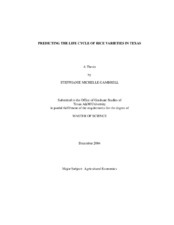| dc.description.abstract | The Texas rice industry has undergone many changes over the course of the industryÂ’s existence. Recently, high costs of production and the structure of government payments have contributed to a decreasing trend in rice acreage planted in Texas. While Texas was once the top rice producer in the United States, it now ranks fifth. Despite the fact that Texas has one of the lowest levels of production among rice producing states, it currently maintains the highest per acre yields.
One of the major factors in maintaining superior yields is the development of high performance rice varieties and hybrids, which provide increased yields on fewer acres. Research institutions invest a great deal of time, effort, and money towards the development of new varieties every year. Each one of these varieties has a specific set of traits that are believed to be in high demand by producers and processors. However, during the developmental stages, scientists are uncertain as to how each new gerplasm will perform once it reaches the market.
This study develops a regression model, which includes competition and the characteristics of a specific variety, to estimate the life cycle of new varieties and hybrids. In addition, simulation techniques are utilized to incorporate risk into the life
cycle, providing a more robust prediction of the cumulative adoption and disadoption path.
Results indicate that the life cycle of new rice varieties is becoming shorter over time. Furthermore, the length of the life cycle is directly related to a new seedÂ’s performance, compared to other varieties on the market. Varieties that provide higher levels of performance, especially higher yields, tend to have a longer life cycle and achieve a larger market share, on average. | en |


